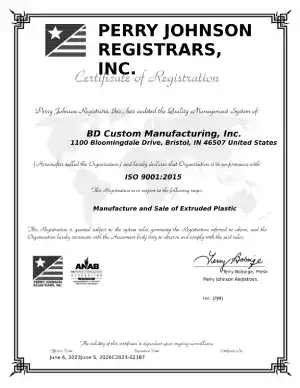What Is Polyvinyl Chloride and What Is It Used For?
Polyvinyl Chloride, most commonly known as PVC, is a synthesized thermoplastic polymer and the third most widely produced synthetic plastic. Unaltered PVC is very brittle, so it requires the addition of plasticizers to make it more durable and functional.
The two most common forms of PVC are rigid unplasticized and flexible plasticized. The rigid form is an unplasticized polymer (RPVC or uPVC). Flexible plasticized is regular PVC. PVC appears in a wide range of applications, including in the construction industry, healthcare industry, signs, and clothing.
What Are the Characteristics of Polyvinyl Chloride (PVC)?
Because PVC is a thermoplastic material, it will become liquid at its melting point and can be reheated after cooling without major degradation.
- Density: With a specific gravity around 1.4, PVC is much denser than other plastics.
- Economical: Being widely available, PVC is a low-cost material that is easy to process.
- Hardness: Rigid PVC is very stiff.
- Strength: Rigid PVC has excellent tensile strength, and flexible PVC has high impact strength.
- Electrical Insulator: PVC does not conduct electricity.
What Are the Advantages of Polyvinyl Chloride?
Readily Available and Inexpensive
PVC is a readily available material that is not expensive to obtain, which makes it ideal for both single-use and long-lasting products.
Very Dense and Hard
PVC resists impact deformation because of its hardness once it is molded for the final application, which creates a longer lifespan for products.
Good Tensile Strength
PVC can withstand an impressive amount of tensile force before reaching its breaking point, which is why it is often used in construction applications.
Resistant to Chemicals and Alkalis
PVC resists all inorganic chemicals, which makes it ideal in the medical industry for consistently sanitized items.
Examples of Custom PVC Extrusion Applications
First used in hospitals to replace rubber tubing and glass containers, custom PVC extrusion is now used for an array of applications, including:
- Basins
- Blood bags
- Bedpans
- Drip chambers
- Catheters
- Hemodialysis equipment
- Enteral feeding devices
- Inflatable splints
- Lab equipment
- IV containers
- Medical gloves
- Packaging
- Respiratory therapy products
- Patient ID bracelets
- Thermal blankets
- Tubing
PVC is replacing many traditional building and construction materials because of its extreme durability and resistance to weathering. It is used in various construction applications, including:
- Caulks
- Fences
- Decking
- Pipes
- Flooring
- Roofing
- Siding
- Wire and cable jacketing
- Sealants
- Windows
- Soffits
- Wall covering
PVC Plastic Extrusion Explained in 5 Steps
Step 1: Raw materials are loaded in a hopper and fed into an extruder. Once in the extruder, a revolving screw moves the materials along.
Step 2: Raw materials flow into the feed throat and into a horizontal barrel with a large spinning screw.
Step 3: Raw materials are heated to their specified temperatures. The melted plastic is then forced through a die to create the finished shape.
Step 4: The extruded plastic is fed onto a conveyor belt to be cooled.
Step 5: The use of a die allows for smooth and even flow throughout the process to achieve the final shape.
Custom PVC Extrusion With BD Custom Manufacturing
BD Custom Manufacturing specializes in custom PVC extrusion for small to mid-sized businesses. Learn more about how our experienced team is ready to serve you with a personal touch. Contact us today for a quote for your next project.


